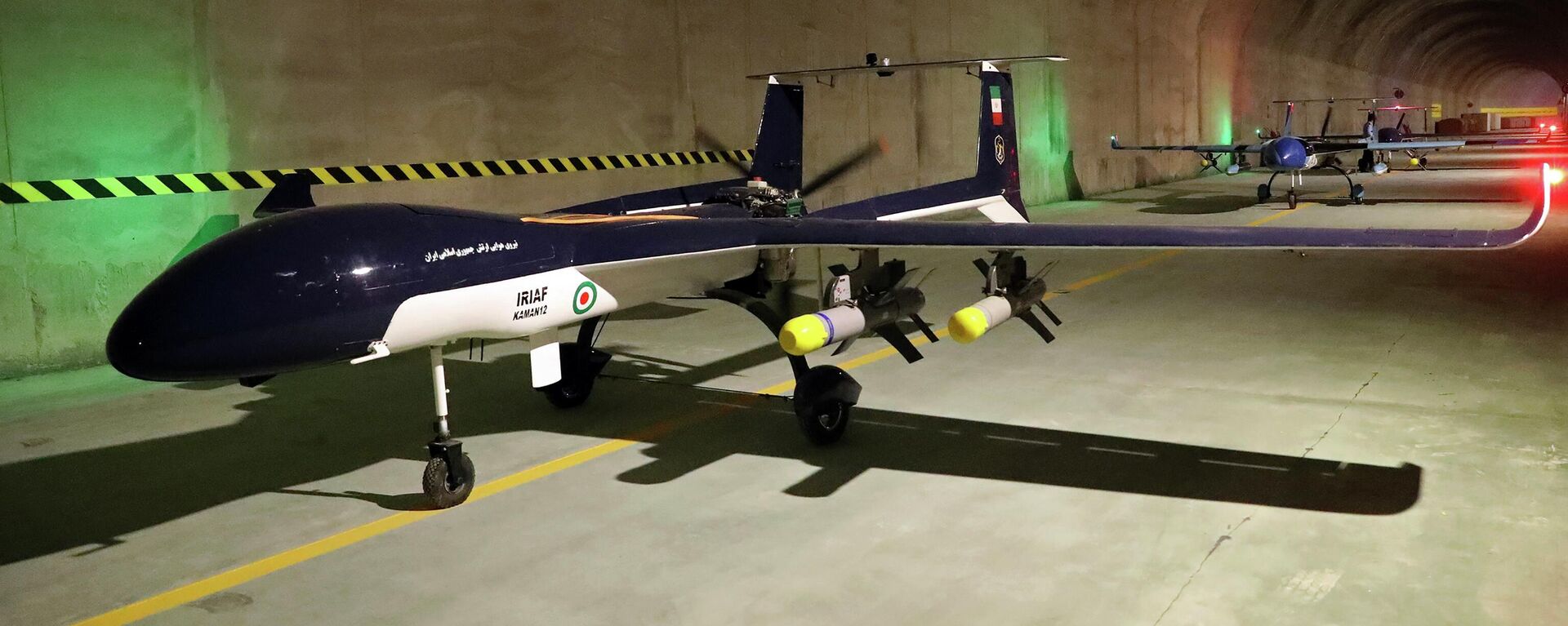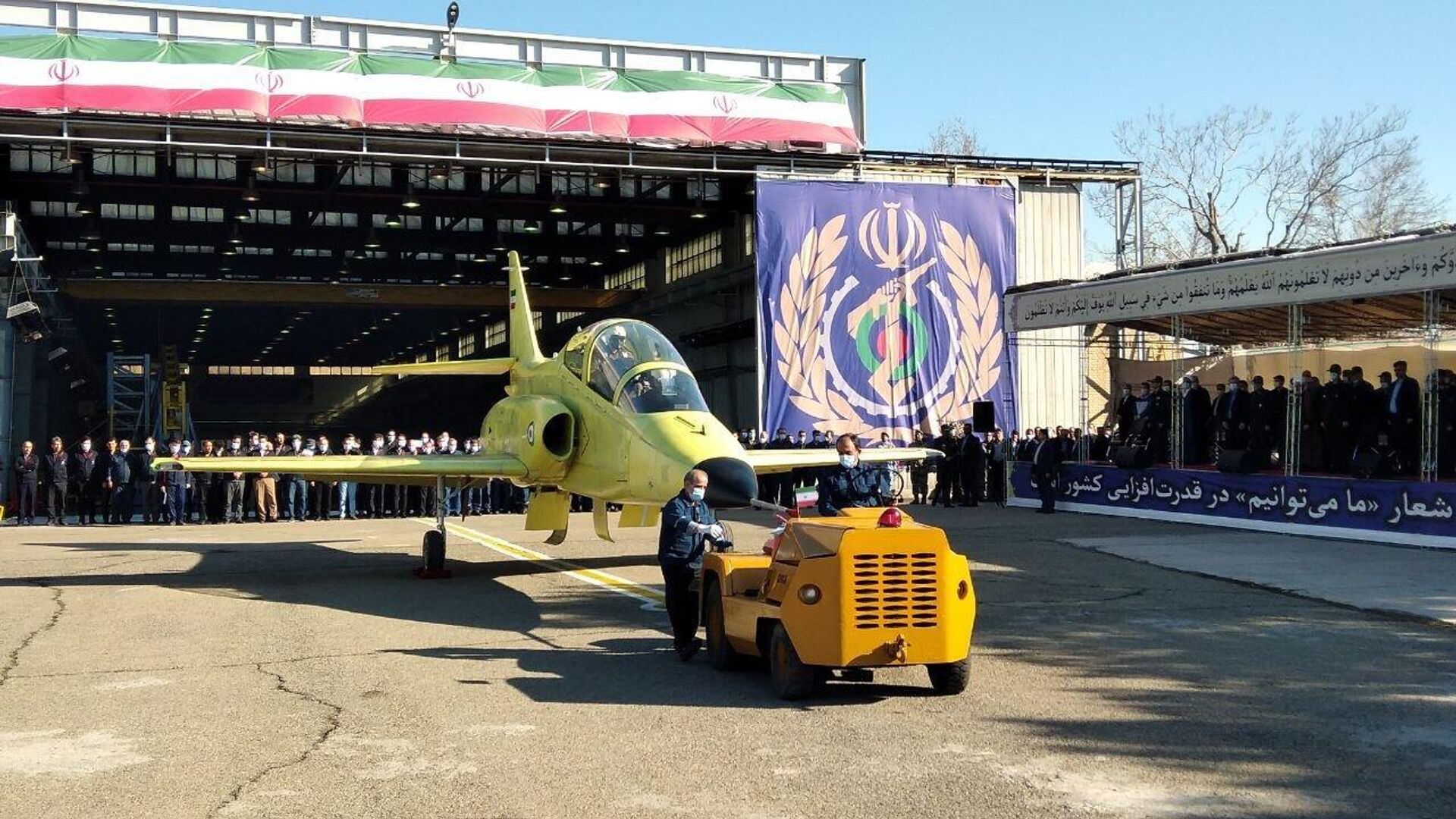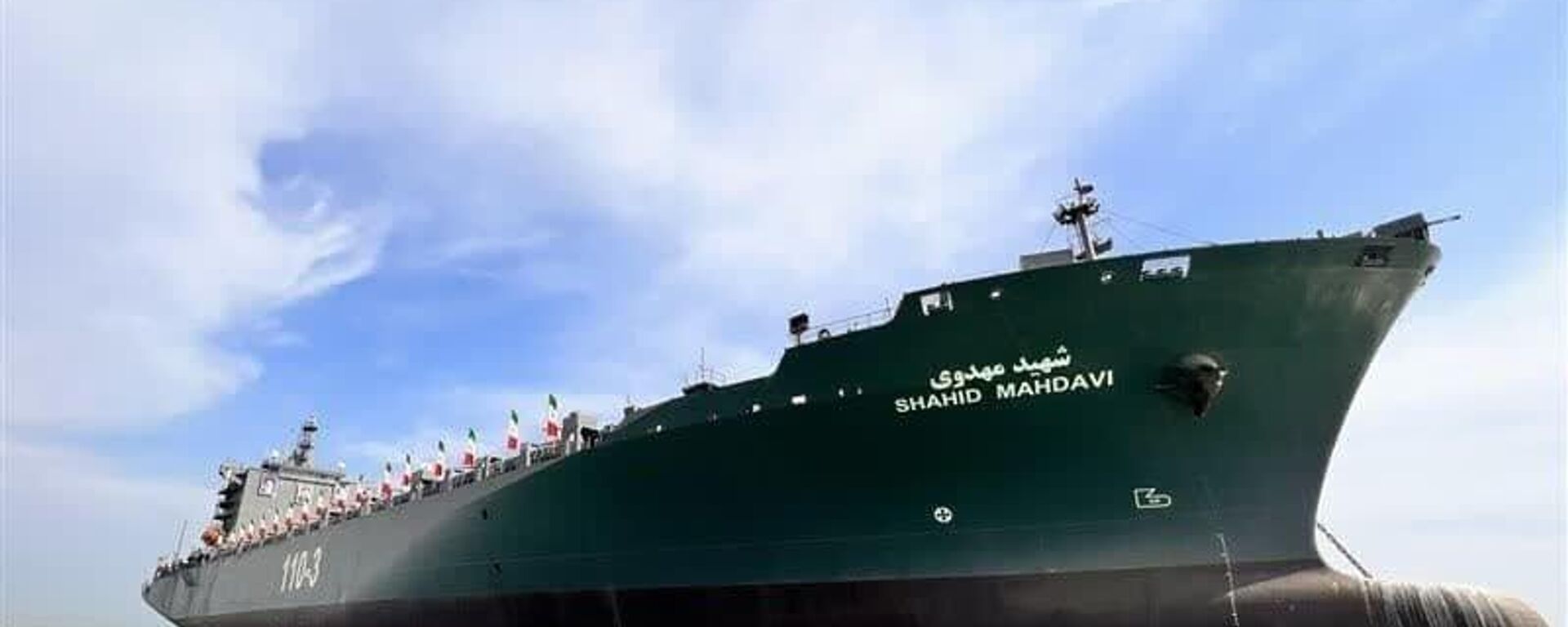https://sputnikglobe.com/20230311/iran-kicks-off-production-of-new-combined-trainer-aircraftclose-air-support-jet-1108296344.html
Iran Launches Production of New Combined Trainer Aircraft/Close Air Support Jet
Iran Launches Production of New Combined Trainer Aircraft/Close Air Support Jet
Sputnik International
Iran lost access to spare parts and maintenance for its fleets of US and French-built aircraft after the 1979 Revolution, and was slapped with a Security Council arms embargo from 2007-2020. While the restrictions were meant to weaken Tehran’s defense capabilities, they instead led to the creation of an advanced domestic defense-industrial complex.
2023-03-11T15:45+0000
2023-03-11T15:45+0000
2023-03-11T15:46+0000
military
iran
trainer
aircraft trainer
close air support
aircraft
jet
plane
unveiling
https://cdn1.img.sputnikglobe.com/img/07e7/03/0b/1108296199_0:0:1280:720_1920x0_80_0_0_ea84cd7446208f5cf001b5430bf681e0.jpg
Iranian aviation giant Iran Aviation Industries Organization (IAIO) has rolled out the production version of the Yasin – a light jet-powered trainer aircraft that’s also capable of flying close air support (CAS) missions.The new jet was unveiled at a ceremony in Tehran on Saturday attended by Defense Minister Mohammad Reza Ashtiani, with the general tasked with formally launching the mass production of the aircraft.“Among our main concern is training fighter pilots, because the process is of paramount significance and requires training aircraft in different classes,” Ashtiani said during the ceremony, addressing reporters and engineers responsible for the Yasin’s development and construction.“The homegrown characteristics of the training jet make it suitable for close air support,” the commander said.“Previously, our fighter pilots used to be trained abroad. The first area affected by the sanctions against our country was this field, which created difficulties for us in terms of training,” Brig. Gen. Hamid Vahedi, the commander of Iran’s Air Force, said at the event. “Utilization of the new aircraft will make training duration shorter and more complete,” he said.Ashtiani said that most of the equipment in the aircraft has been localized, thereby reducing Iran’s dependence on forces or factors beyond its ability to control.A prototype of the Yasin was first unveiled in late 2019, with the production model presented Saturday apparently a refined and upgraded version featuring a domestically-developed radar, avionics, engine, landing gear and ejection seats.The Yasin is a light-weight aircraft which weighs about 5.5 tons, has a range of up to 1,200 km and a flight speed of up to 1,000 km. The twin-engined, two-man crewed jet has a thrust of 3,200 kg, on par with the MiG-AT, an advanced trainer/light attack prototype developed by the Mikoyan Design Bureau in the 1990s. The Yasin’s flight ceiling is 11 km, and it has a runway length requirement of 800 meters. Its maximum takeoff weight is 6,600 kg. The aircraft can remain in the air for an hour and a half using internal fuel tanks, or two hours with attachable external tanks.The Yasin joins nearly a dozen trainers already in the Iranian Air Force’s arsenal, including the Fajr F.3, the Dorna, and the Simorgh. Iran also has Chinese-built Chengdu FT-7, French-made Socata TB, Pakistani MFI-17 Mushshak, Swiss Pilatus PC-7 Turbos and US-made Beachcraft Bonanza trainers in its inventory. Iran’s ground attack fleet consists of Russian Sukhoi Su-24s and the Azarakhsh, an Iranian-built light attack jet built on the basis of the Northrop F-5, a US warplane that Iran inherited after the Islamic Revolution in 1979.Iran has not let the decades that it has spent under crushing Western and international sanctions go to waste, creating one of the largest and most comprehensive defense industrial complexes in the Middle East, and producing everything from advanced missile systems and long-range radars, to a homegrown defense electronics sector.
https://sputnikglobe.com/20221020/43-years-under-sanctions-how-iran-built-drones-1102475565.html
https://sputnikglobe.com/20230309/power-projection-iranian-style-watch-irgc-unveil-massive-new-warship-built-from-container-ship-1108232049.html
iran
Sputnik International
feedback@sputniknews.com
+74956456601
MIA „Rossiya Segodnya“
2023
News
en_EN
Sputnik International
feedback@sputniknews.com
+74956456601
MIA „Rossiya Segodnya“
Sputnik International
feedback@sputniknews.com
+74956456601
MIA „Rossiya Segodnya“
iran, trainer, close air support, jet, aircraft, plane, warplane, unveils
iran, trainer, close air support, jet, aircraft, plane, warplane, unveils
Iran Launches Production of New Combined Trainer Aircraft/Close Air Support Jet
15:45 GMT 11.03.2023 (Updated: 15:46 GMT 11.03.2023) Iran lost access to spare parts and maintenance for its fleets of US and French-built aircraft after the 1979 Revolution, and was slapped with a Security Council arms embargo from 2007-2020. While the restrictions were meant to weaken Tehran’s defense capabilities, they instead led to the creation of an advanced domestic defense-industrial complex.
Iranian aviation giant Iran Aviation Industries Organization (IAIO) has rolled out the production version of the Yasin – a light jet-powered trainer aircraft that’s also capable of flying close air support (CAS) missions.
The new jet was unveiled at a ceremony in Tehran on Saturday attended by Defense Minister Mohammad Reza Ashtiani, with the general tasked with formally launching the mass production of the aircraft.
“Among our main concern is training fighter pilots, because the process is of paramount significance and requires training aircraft in different classes,” Ashtiani
said during the ceremony, addressing reporters and engineers responsible for the Yasin’s development and construction.
“The homegrown characteristics of the training jet make it suitable for close air support,” the commander said.
“Previously, our fighter pilots used to be trained abroad. The first area affected by the sanctions against our country was this field, which created difficulties for us in terms of training,” Brig. Gen. Hamid Vahedi, the commander of Iran’s Air Force, said at the event. “Utilization of the new aircraft will make training duration shorter and more complete,” he said.
Ashtiani said that most of the equipment in the aircraft has been localized, thereby reducing Iran’s dependence on forces or factors beyond its ability to control.
A prototype of the Yasin was first unveiled in late 2019, with the production model presented Saturday apparently a refined and upgraded version featuring a domestically-developed radar, avionics, engine, landing gear and ejection seats.

20 October 2022, 17:56 GMT
The Yasin is a light-weight aircraft which weighs about 5.5 tons, has a range of up to 1,200 km and a flight speed of up to 1,000 km. The twin-engined, two-man crewed jet has a thrust of 3,200 kg, on par with the MiG-AT, an advanced trainer/light attack prototype developed by the Mikoyan Design Bureau in the 1990s. The Yasin’s flight ceiling is 11 km, and it has a runway length requirement of 800 meters. Its maximum takeoff weight is 6,600 kg. The aircraft can remain in the air for an hour and a half using internal fuel tanks, or two hours with attachable external tanks.
The Yasin joins nearly a dozen trainers already in the Iranian Air Force’s arsenal, including the Fajr F.3, the Dorna, and the Simorgh. Iran also has Chinese-built Chengdu FT-7, French-made Socata TB, Pakistani MFI-17 Mushshak, Swiss Pilatus PC-7 Turbos and US-made Beachcraft Bonanza trainers in its inventory. Iran’s ground attack fleet consists of Russian Sukhoi Su-24s and the Azarakhsh, an Iranian-built light attack jet built on the basis of the Northrop F-5, a US warplane that Iran inherited after the Islamic Revolution in 1979.
Iran has not let the decades that it has spent under crushing Western and international sanctions go to waste, creating one of the largest and most comprehensive defense industrial complexes in the Middle East, and producing everything from advanced missile systems and long-range radars, to a homegrown defense electronics sector.




